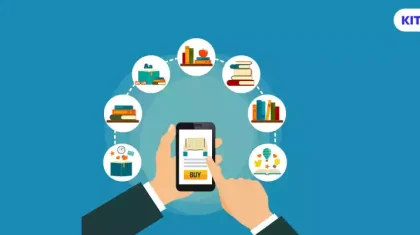
Cracking the Code: How to Ace Every School RFP, A Secret for K12 Publishers
Summarize this blog with your favorite AI:
Winning a school RFP has become integral for K12 publishers who want to secure state contracts or projects in a competitive education sector. The type of education sector RFP can vary from school to school.
Some examples are a K12 RFP for curriculum materials, a school technology RFP for digital platforms, or a request for a proposal for education projects. Understanding the education sector RFP process is essential.
According to a report, the education technology market alone is expected to jump to 348.41 billion by 2030. It emphasizes digital learning and the priority of schools and districts. This also justifies the growing value of well-written K12 RFPs.
Here is where the expertise and experience of digital textbook platforms like KITABOO come into play. In this guide, let’s learn more about RFPs and explore significant strategies for K12 publishers to write effective requests for proposals for education projects.
Table of Contents:
I. What is a K12 RFP or a Request for Proposal for Education Project
- Introduction and Background
- Scope of Work
- Requirements of Proposal Submission
- Evaluation Criteria
- Budget and Pricing
III. Key Strategies to Write an Effective K12 RFP
- Understand the School Needs
- Be Concise
- Show Unique USPs or Value Propositions
- Show Evidence
- Check Submission Guidelines
- Budget Clarity
IV. How a Well-Written School Technology RFP Changes Your Publication Success
V. Conclusion
What is a K12 RFP or a Request for Proposal for Education Projects?
A Request for Proposal (RFP) is a document issued by organizations to solicit bids for projects. In the education sector, RFPs are an essential tool for acquiring school services and products.
For K12 publishers, an RFP means submitting elaborate proposals that show how their product can resolve challenges and provide for requirements that have been given in the RFP document.
The 2024 National Educational Technology Plan is a comprehensive approach that reframes and realizes the potential of educational technology in schools and universities.
This calls for the significance of RFPs on technology, curriculums, and infrastructures. To win such propositions, K12 publishers must:
- Be aware of the school’s pain points.
- Develop customized and comprehensive education sector RFPs.
- Consider the latest trends in education, such as personalized learning and AI-driven tools.
- Prioritize tight budgets and high expectations for solutions.
This makes it necessary for publishers to gain knowledge and understanding of writing an effective RFM in 2025.
For school districts, RFPs are very critical as they:
- Offer fair competition and transparency.
- Enable schools to compare different vendors fairly.
- Challenge the vendors to come up with appropriate solutions.
K-12 publishers must prepare effective education sector RFPs to connect with decision-makers. Understanding an RFP, evaluating the thinking behind its formation, and preparing responses is critical.
Features of a K12 RFP
A well-formatted K-12 RFP builds the foundation for an effective procurement process. It empowers and enables publishers to develop an effective response after understanding its key components. Not all education RFPs are the same. In general, there could be some differences. However, most School RFPs have the following components:
1. Introduction and Background
K-12 organizations start with their profile of either the issuing school, state, or district. They ensure that the objectives for the K12 RFP are identified.
2. Scope of Work
This section explains the requirements of a particular project. It can include information related to product features, service expectations, cost and budget, marketing capabilities, or technology solutions. It can further elaborate on deliverables and project timelines.
3. Requirements of Proposal Submission
This section of the K12 RFP guides K12 publishers on the necessary formatting, technicalities, page limits, and submittal deadlines. It may also suggest eligibility requirements or require the completion of specific forms or certifications.
4. Evaluation Criteria
The next section elaborates on how the request for proposals for education projects will be evaluated. This evaluation can be in terms of cost, quality, submission guidelines, alignment with district goals, etc. It may also come with scoring rubrics to make the assessment more transparent.
5. Budget and Pricing
This section instructs K12 publishers to include detailed breakdowns of costs associated with their proposals. They must cover funding or budgetary limitations.
Key Strategies to Write an Effective K12 RFP
To write an effective K12 RFP, publishers must align school priority with product offering with careful planning. Here are the key strategies that publishers must follow:
1. Understand the School Needs
Start by analyzing the RFP document to understand what the school wants. Point out grey areas and discuss customized solutions that align well with their goals.
2. Be Concise
When writing a request for a proposal for education projects, ensure that the language used is clear. Avoid jargon and unnecessary complexity, and be straight to the point. It is best to add multimedia-enriched content like graphs, statistics, and page structures. It is better to collaborate with elite digital textbook platforms like KITABOO, which can help you frame rich and effective K12 RFPs. The bottom line is to make it simpler for reviewers to review the proposal.
3. Show Unique USPs or Value Propositions
Publishers must highlight what makes their solution the best. Whether it’s about offering innovative features, measuring success statistics, or introducing new tools, it is significant to emphasize value.
4. Show Evidence
It is recommended to use feedback, real-life case studies, testimonials, and references to verify any claims. K12 publishers must document tangible results from similar projects.
5. Check Submission Guidelines
It is imperative to follow all instructions on what to submit, deadlines, and even formatting requirements. This will keep the proposal from being disqualified.
6. Budget Clarity is Important
Provide transparent pricing with breakdowns of costs and deliverables. Personalizing the education sector RFP and offering to resolve school/district challenges specifically customized to their needs
How a Well-Written School Technology RFP Changes Your Publication Success
A well-written School RFP has excellent possibilities for K12 Publishers. Some of them are:
- Bid-Winning Competency: A higher level of chance in such conditions to win the bid over competitors.
- Credibility Building: A well-written education sector RFP reflects how you prioritize school necessities and enhances your confidence that you will not betray the trust.
- Expanding Market Reach: Winning RFPs give publishers an opening in new streams or institutions and create space for them in the expanding education marketplace.
- Exposing Innovation: An excellent RFP response can demonstrate your ability to present up-to-date solutions and show how well-versed you are in modern trends in education.
- Long-term Collaboration Opportunities: Successful RFPs may lead to long-term relationships with the schools involved.
Conclusion
Writing an effective Education Sector RFP requires K12 publishers to show their expertise, preparation, and understanding of the specific needs of education. With a rapidly evolving K12 industry, publishers must offer value-driven solutions supported by data, innovation, and clarity in proposals.
Collaborate with digital textbook platforms like KITABOO to deliver digital-first, personalized school technology RFP solutions. From integrating technology to enhancing curricula, K12 publishers need to adopt strategies that make them problem solvers rather than vendors.
Get help from our team to get the right guidance to ace all your school RFPs!
Also check:
Discover how a mobile-first training platform can help your organization.
KITABOO is a cloud-based platform to create, deliver & track mobile-first interactive training content.


